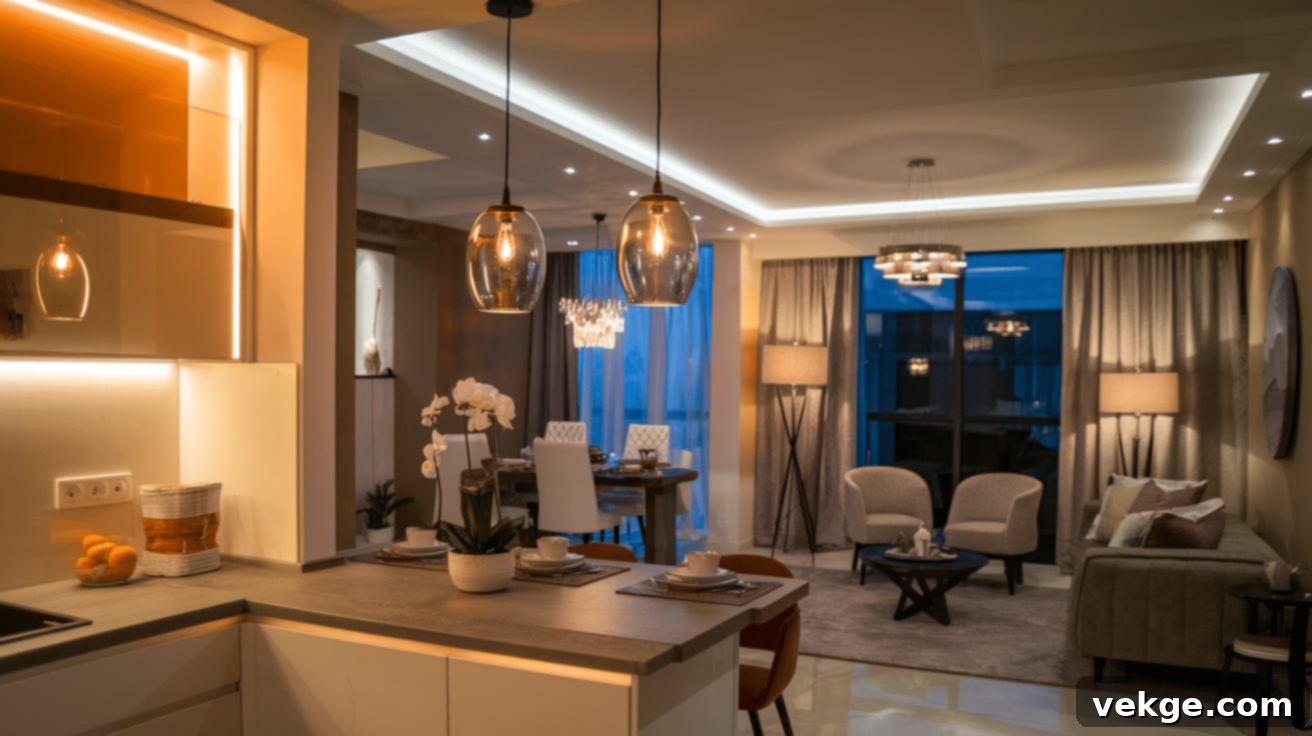Illuminate Your Life: Essential Guide to Home Lighting Upgrades for Enhanced Comfort and Energy Savings
Have you ever noticed how the right light can completely transform an ordinary room into something truly exceptional? It’s more than just providing visibility; good lighting fundamentally changes how a space feels, operates, and even how it’s perceived. Thoughtful lighting can drastically cut down on power bills, highlight your home’s best features, and surprisingly, even add significant value to your property.
Consider the rooms where you feel most comfortable and at ease. Chances are, those spaces benefit from carefully planned lighting that perfectly suits their purpose and your activities within them. From bright task lighting in a kitchen to warm, ambient glow in a living room, the impact is undeniable.
This comprehensive guide is designed to help you navigate the world of lighting, empowering you to make informed choices that truly work for you. We’ll explore options that align with your specific needs, respect your budget, and perfectly complement your personal style. Whether you’re looking for a simple bulb swap or a complete system overhaul, you’re in the right place.
Ready to brighten your home and create spaces you’ll absolutely love spending time in? Let’s explore some effective and simple ways to upgrade your lighting and unlock its full potential.
Why Modern Lighting Upgrades Matter for Every Home
Upgrading your home’s lighting is more than a cosmetic choice; it’s a strategic investment with multiple tangible benefits. Beyond aesthetics, modern lighting solutions offer significant improvements across various aspects of home living.
Energy Savings: A Brighter Future, Lower Bills
One of the most compelling reasons to update your lighting is the potential for substantial energy savings. Modern lighting technologies, particularly LEDs, use significantly less electricity than outdated incandescent or fluorescent bulbs. This direct efficiency translates into noticeably lower utility bills month after month, year after year. By reducing your energy consumption, you’re not only saving money but also contributing to a smaller carbon footprint, making your home more environmentally friendly.
Visual Improvement: Enhancing Aesthetics and Ambiance
Better lighting naturally leads to improved visual appeal. The right fixtures and bulbs can dramatically enhance the aesthetic of any room. They can make colors appear truer, highlight architectural details or cherished artwork, and create a more inviting and comfortable atmosphere. Thoughtful lighting design can make small rooms feel larger, and large rooms feel cozier, all while improving the overall visual quality of your home.
Improved Safety and Functionality: Light Up Your Life Safely
Proper lighting is crucial for both safety and functionality. Adequate illumination reduces eye strain, making everyday tasks like reading, cooking, or working at a desk much easier and more comfortable. It also significantly lowers the risk of accidents by ensuring you can clearly see obstacles and pathways. In areas like staircases, bathrooms, and kitchens, good lighting is not just a convenience but a critical safety feature.
Increased Home Value: A Luminous Investment
Updated lighting is a significant factor that can increase your home’s market value. When potential buyers tour properties, modern and well-designed lighting systems immediately convey a sense of a well-maintained and contemporary home. It instantly upgrades the perceived quality and functionality of every space, making your property more attractive and often leading to a higher sale price. It’s an investment that pays dividends, both in daily enjoyment and future resale.
Diverse Types of Lighting Upgrades for Every Need
Lighting technology has advanced remarkably in recent years, presenting a wealth of innovative options for both homeowners and businesses. You can now discover solutions that drastically reduce power consumption while delivering superior quality light compared to older, inefficient systems. From straightforward bulb replacements to comprehensive system overhauls, the right lighting modifications can render your rooms more functional, comfortable, and cost-effective for years to come. Let’s explore some of the most popular and impactful upgrade types.
1. LED Replacements: The Simple Switch for Massive Savings
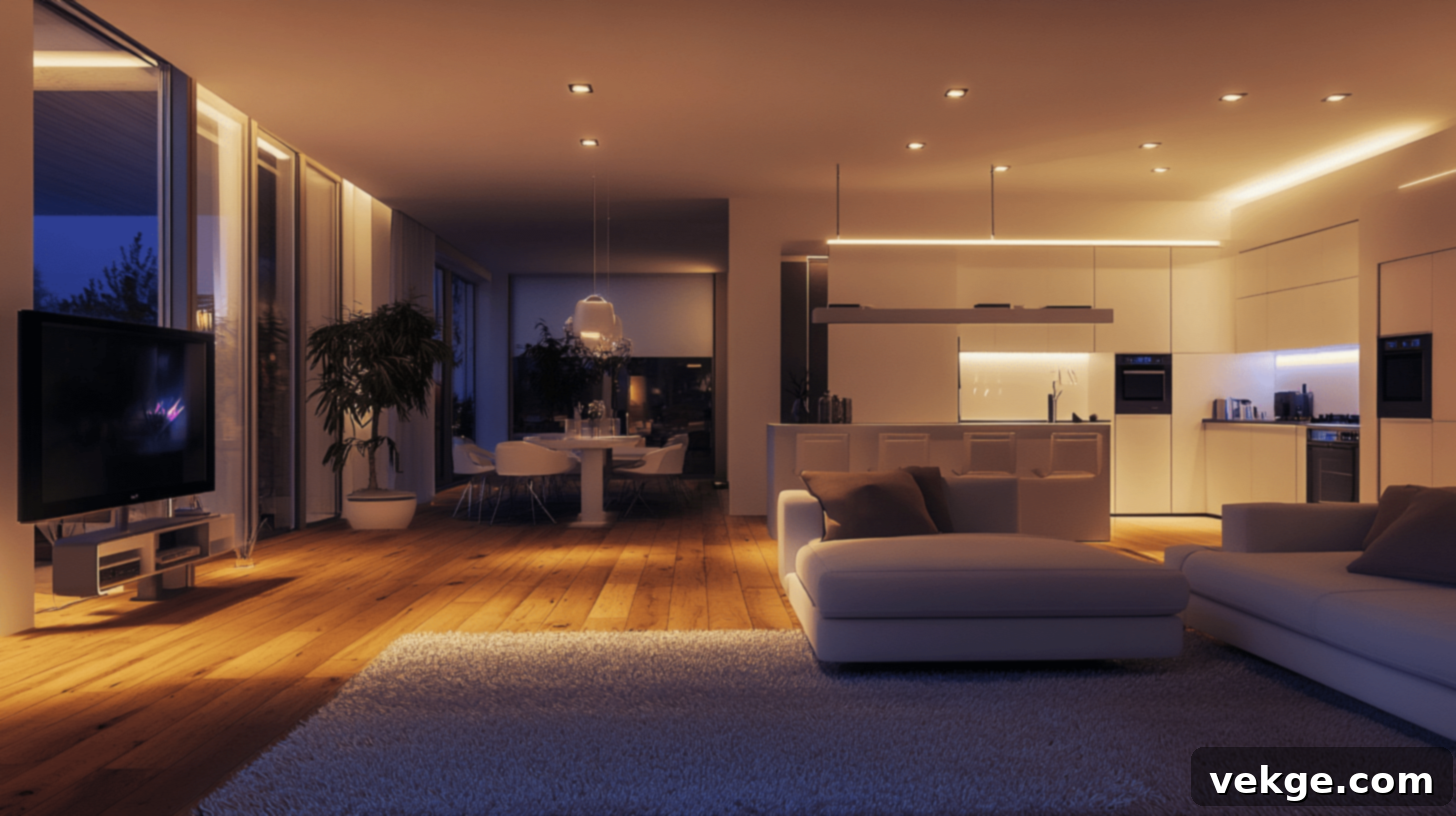
Opting for LED replacements is arguably the simplest and most impactful way to update your lighting. By merely swapping out old incandescent or fluorescent bulbs for modern LEDs, you can slash energy consumption by up to 75%. Beyond the immediate energy savings, LEDs boast an impressively long lifespan, often lasting 15 to 25 times longer than traditional bulbs, meaning fewer replacements and less waste.
The vast majority of LED bulbs are designed to be compatible with your existing fixtures, making this a highly budget-friendly option that typically requires no special tools or advanced skills. Furthermore, LEDs operate at much cooler temperatures than older bulbs, significantly reducing fire risks and contributing to a more comfortable indoor environment, especially during warmer months.
2. Smart Lighting Systems: Control at Your Fingertips
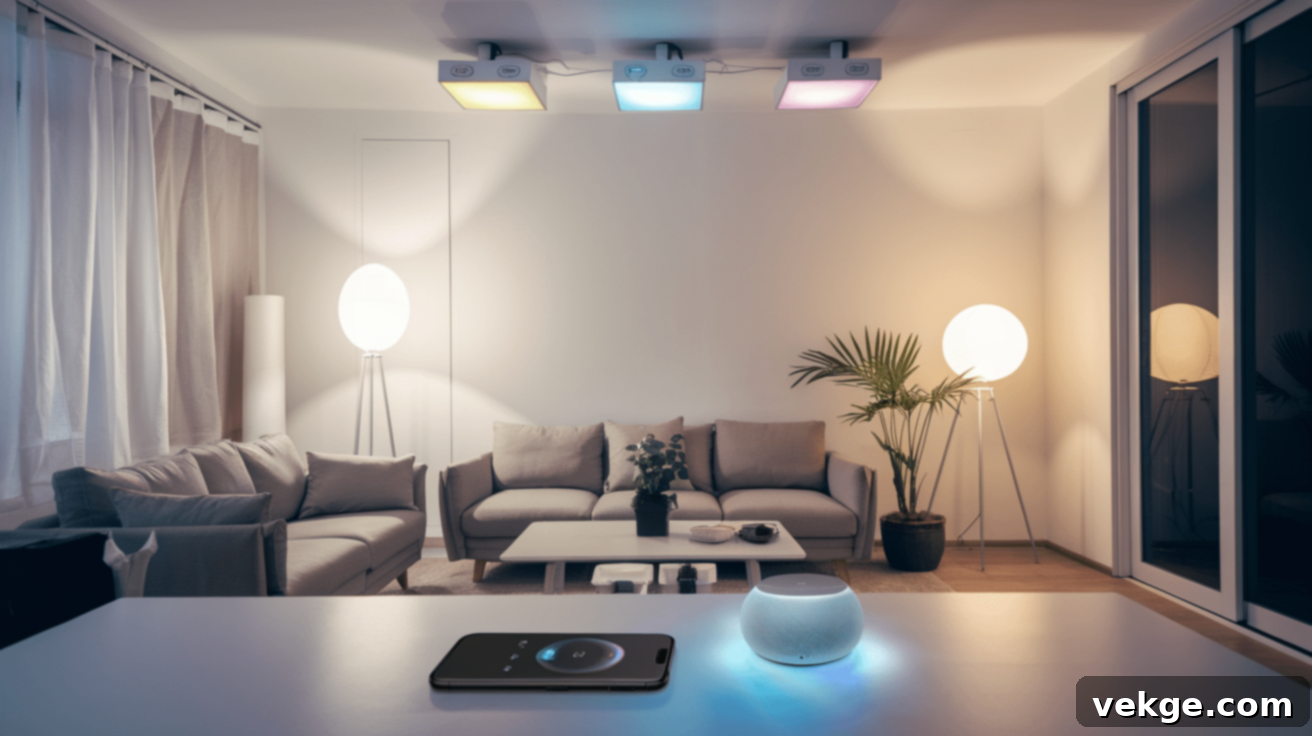
Smart lighting systems usher in a new era of convenience and control, allowing you to manage your lights effortlessly from your smartphone, tablet, or with simple voice commands. These sophisticated systems enable you to set schedules for lights to turn on and off automatically, dim them to create the perfect mood, or even change their color in compatible setups.
Such systems make it incredibly easy to adjust lighting based on the time of day, your current activity, or even your mood. They are also highly effective in cutting energy costs by ensuring unused lights are automatically turned off. Many smart systems seamlessly integrate with other home automation devices, such as thermostats or security cameras, offering a more unified and intelligent home management experience. Installation is often straightforward, with numerous plug-and-play options and those designed to work with your existing wiring and fixtures.
3. Layered Lighting: Crafting Depth and Dimension
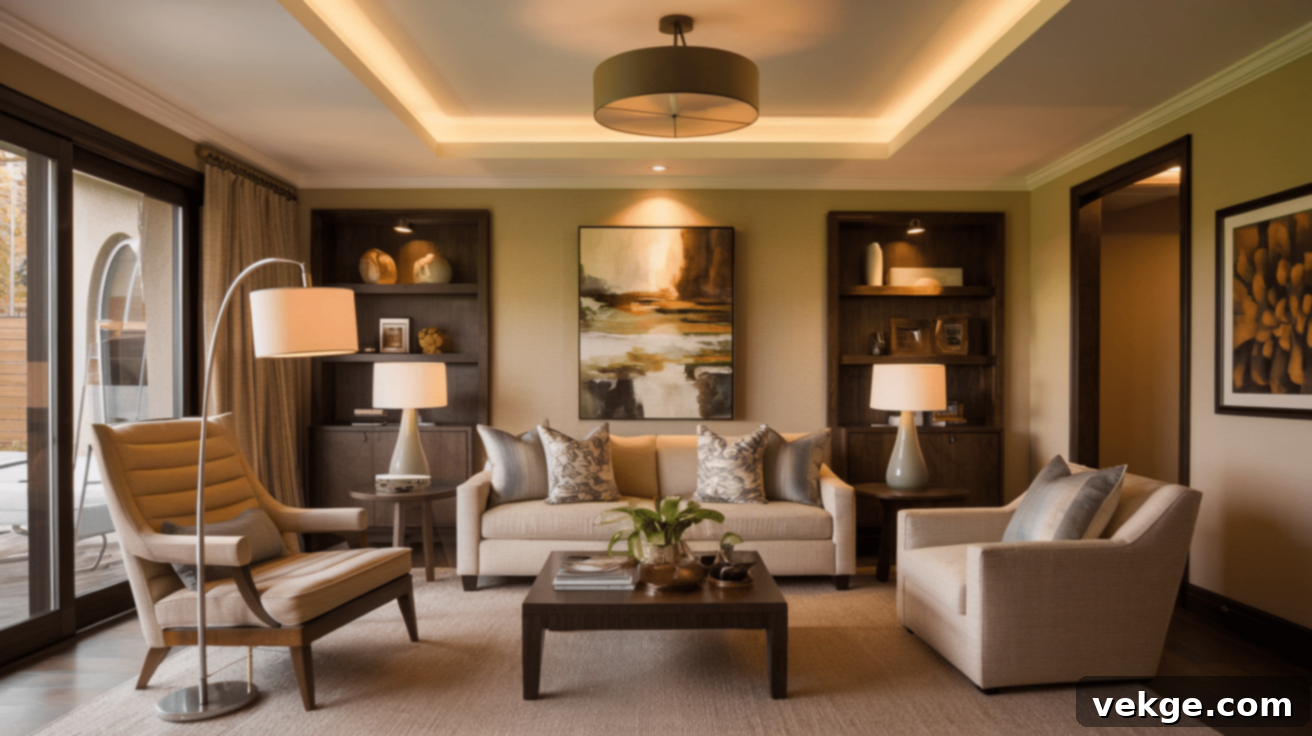
Layered lighting is an advanced design technique that involves using three distinct types of light sources to create depth, functionality, and visual interest in a room. This approach moves beyond a single overhead light to provide a richer, more adaptable illumination scheme:
- Ambient lighting: This forms the base layer, providing general illumination for the entire room. Think of ceiling fixtures, chandeliers, or recessed lights that evenly light the space. Its purpose is to provide overall brightness and a foundational level of light.
- Task lighting: Focused and brighter, task lighting illuminates specific areas where detailed activities take place. Examples include pendant lights over kitchen counters, desk lamps for reading or working, and vanity lights in bathrooms. It reduces eye strain and enhances focus for particular tasks.
- Accent lighting: This layer is used to highlight specific features, creating visual drama and focal points. It can be achieved with track lighting, picture lights, or strategically placed spotlights to draw attention to artwork, plants, architectural details, or built-in shelving. Accent lighting adds character and depth to a room.
By combining these three layers, you achieve a versatile lighting scheme that can be adjusted for different moods, times of day, and functional needs, making any room feel more sophisticated and inviting.
4. Color Temperature Optimization: Setting the Perfect Mood
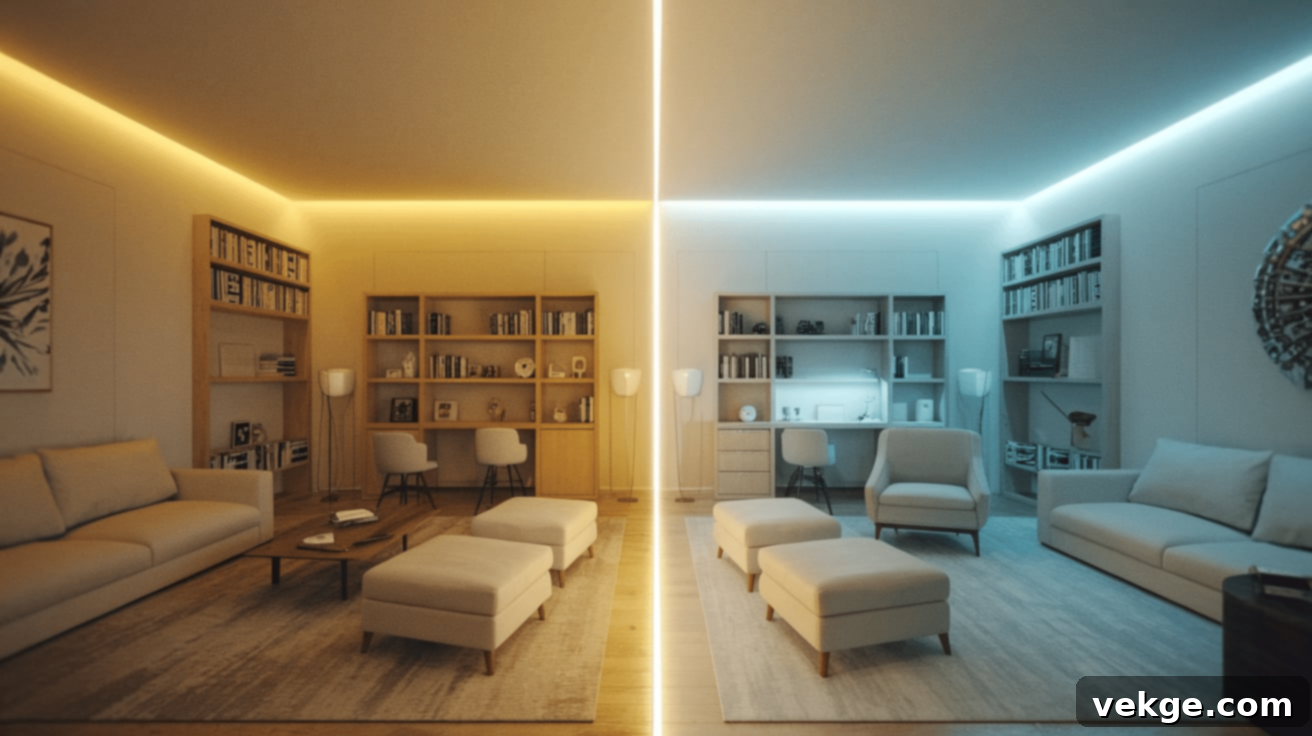
The “color temperature” of your lights, measured in Kelvin (K), significantly influences the mood and feel of a space. Warm light (typically 2700-3000K) emits a soft, yellowish glow reminiscent of traditional incandescent bulbs, fostering relaxed, cozy, and inviting atmospheres. This is ideal for living rooms, bedrooms, and dining areas where comfort and relaxation are priorities.
Conversely, cooler light (4000-5000K) produces a brighter, more bluish-white light that enhances focus, visibility, and alertness. It’s perfect for task-oriented areas like kitchens, home offices, or workshops where clear vision and concentration are essential. Matching these color temperatures to the function of each room vastly improves comfort and usefulness. Many modern LED bulbs now offer adjustable color temperature settings, often controllable via a simple switch on the bulb itself or through a smart app, allowing for unparalleled flexibility.
5. Motion Sensor Integration: Smart Savings and Enhanced Security
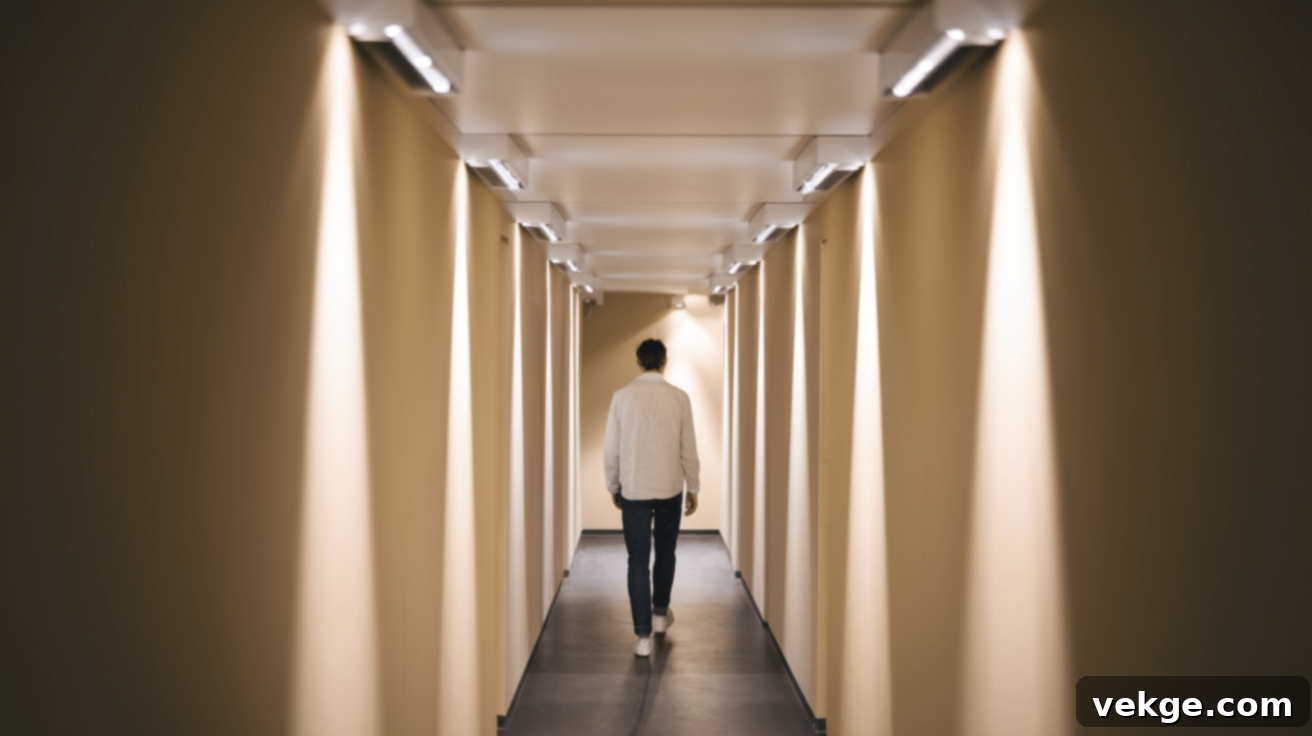
Integrating motion sensors into your lighting system, particularly in high-traffic or intermittently used areas like hallways, bathrooms, pantries, garages, and outdoor spaces, offers tremendous benefits in terms of energy savings and convenience. Lights equipped with motion sensors automatically turn on when movement is detected and then switch off after a preset period of no activity. This intelligent automation ensures lights are only on when needed, drastically reducing wasted electricity.
Beyond energy efficiency, motion sensors enhance safety and convenience, especially for individuals carrying items, children, or the elderly who might find reaching for switches difficult. For exterior applications, motion-activated lights serve as an excellent security feature, deterring potential intruders by illuminating unexpected movement. Installation is often quite simple, with many modern options requiring minimal or no significant wiring changes.
6. Recessed Lighting Installation: Seamless Illumination
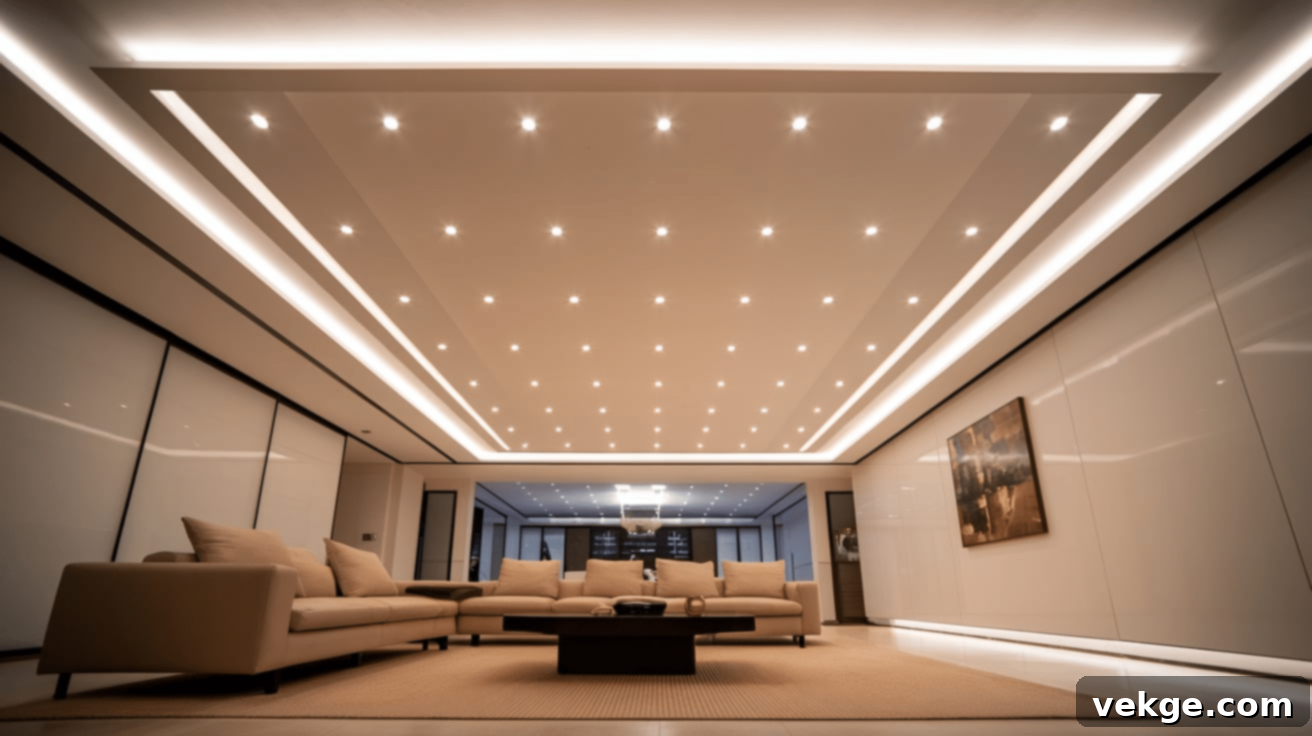
Recessed lighting, also known as can lights or downlights, is a popular choice for achieving a clean, modern aesthetic. These fixtures are installed flush with the ceiling, providing excellent light coverage without the visual clutter of hanging fixtures. They are particularly effective in rooms with lower ceilings, where they can make the space feel larger and more open.
Modern LED recessed lights are incredibly energy-efficient and come in various beam angles, allowing you to direct light precisely where it’s needed. This makes them ideal for highlighting wall art, architectural features, or specific work areas. When installed with proper insulation, these fixtures also prevent heat loss through your ceiling, further contributing to energy efficiency. Their discreet design ensures they blend seamlessly into any decor while providing powerful and versatile illumination.
7. Natural Light Enhancement: Harnessing the Power of the Sun

Maximizing natural daylight is one of the most effective and healthy ways to illuminate your home. This approach focuses on integrating and enhancing sunlight through various architectural elements such as adding new windows, installing skylights, incorporating solar tubes (or “sun tunnels”), or utilizing light shelves. Solar tubes, for example, can brilliantly bring natural light into interior rooms that lack windows, transforming dark spaces.
By intelligently combining natural light with artificial lighting systems that adjust based on ambient sunlight levels (daylight harvesting), you can create spaces that feel more open, vibrant, and alive, while significantly reducing electricity consumption during daylight hours. Furthermore, ample sunlight exposure offers numerous health benefits, positively impacting mood, alertness, and regulating natural sleep cycles. Even simple actions like regularly cleaning windows or trimming outdoor plants that block light can dramatically improve the influx of natural light into your home.
Residential vs. Commercial Lighting Needs: A Comparative Overview
While both residential and commercial lighting aim to illuminate spaces, their primary functions and requirements differ significantly. Residential lighting primarily focuses on creating comfort, ambiance, and a sense of personal style, with varied lighting patterns that adapt to different activities and times of day. Commercial settings, in contrast, demand consistent, often brighter illumination to support worker productivity, ensure safety compliance, and minimize operational costs through durable, long-lasting, and low-maintenance fixtures. Understanding these distinctions is crucial for selecting appropriate lighting solutions.
| Factor | Residential Lighting | Commercial Lighting |
|---|---|---|
| Primary Purpose | Comfort, aesthetics, mood creation, personal expression | Productivity, functionality, safety compliance, brand image |
| Usage Patterns | Varied throughout the day, often intermittent; adaptable for different activities | Extended hours, consistent usage, often programmed for specific operating times |
| Light Quality | Warm tones preferred (2700-3000K) for coziness; dimmability important | Brighter, cooler tones (3500-5000K) for alertness; high CRI (color rendering index) for specific tasks |
| Energy Priorities | Smart controls for occupied rooms, individual dimming, energy-efficient bulbs | High-efficiency fixtures for long runtimes, centralized controls, daylight harvesting |
| Design Focus | Matches home decor, personal style, layered lighting for ambiance | Functional, uniform illumination, low-maintenance design, scalable systems |
| Maintenance Concerns | Appearance, ambiance, ease of bulb replacement for homeowners | Longevity, ease of replacement, minimal downtime, bulk purchasing, service contracts |
| Installation Complexity | Often simpler, fewer fixtures per room, DIY-friendly for basic tasks | More complex, larger-scale systems, extensive wiring, specialized equipment, professional installation typically required |
| Control Systems | Individual switches, dimmers, smart home integration (voice, app control) | Centralized building management systems, programmed schedules, occupancy sensors, networked lighting |
| Cost Considerations | Initial purchase price, aesthetic value, ease of installation | Lifetime cost, energy usage, replacement cycles, maintenance costs, tax benefits for efficiency |
| Regulatory Requirements | Minimal code compliance for general electrical safety | Strict compliance with building codes, safety regulations, energy efficiency standards (e.g., ASHRAE, Title 24) |
DIY vs. Hiring a Professional: Making the Right Choice for Your Lighting Project
Deciding whether to tackle a lighting project yourself or to enlist the help of a professional electrician depends on several factors, including the complexity of the task, your personal skill level, and safety considerations. Simple light fixture changes can often be a satisfying DIY project, saving money and providing a sense of accomplishment. However, for more intricate work involving new wiring, circuit modifications, or high ceilings, professionals offer invaluable expertise, safety knowledge, and specialized equipment that can prevent costly mistakes and potential hazards.
When to Do It Yourself: Simple Upgrades for the Savvy Homeowner
Many lighting upgrades are perfectly manageable for homeowners with basic tools and a modicum of electrical safety knowledge. Swapping out existing light bulbs for energy-efficient LEDs, for example, is a straightforward task. Replacing simple, existing light fixtures like ceiling flush mounts or wall sconces, where no new wiring is required, can also be a successful DIY endeavor. Installing basic dimmer switches, provided you’re comfortable working with electrical connections, is another common homeowner project. Furthermore, many modern smart lighting options are designed as plug-and-play systems that don’t require any wiring modifications, making them ideal for beginners looking to experiment with smart home technology.
When to Call a Professional: Ensuring Safety and Expertise
Safety should always be your paramount concern when dealing with electrical projects. Any task that involves adding new wiring, modifying existing circuits, or installing entirely new fixtures where no previous wiring existed absolutely calls for the specialized skills and knowledge of a licensed electrician. Complex lighting systems with multiple control zones, advanced smart home integration, or specialized features are also best left to experts who possess a deep understanding of the technology and installation requirements.
Older homes, particularly those with outdated electrical systems, necessitate special care to prevent fire hazards and ensure compliance with current electrical codes. Remember that many electrical projects, especially those involving significant alterations, legally require permits and inspections from local authorities. A professional electrician will be well-versed in these requirements and can properly handle all necessary permits and ensure your installation meets all safety and code standards, providing you with peace of mind.
How to Choose the Right Lighting Fixtures: A Guide to Style and Function
Selecting the perfect lighting fixtures for your home goes beyond mere aesthetics; it’s about balancing functionality, style, and efficiency. Thoughtful choices can profoundly impact the comfort, usability, and overall appeal of each room. When embarking on your lighting upgrade journey, here’s what to keep firmly in mind to make choices that illuminate your space beautifully and effectively.
1. Size and Placement: The Key to Visual Harmony
The size of your lighting fixtures must always be in proportion to your room’s dimensions and the furniture it contains. A chandelier that’s too small for a grand dining room will look lost, while an oversized pendant light can easily overwhelm a compact space. Proper placement is equally critical to achieve optimal illumination and visual balance. For instance:
- Dining room light fixtures generally perform best when suspended approximately 30-36 inches above the table surface, ensuring adequate light without obstructing views or creating harsh glare.
- Kitchen island fixtures should typically be positioned 30-40 inches above the counter, providing focused task lighting while maintaining an open feel.
- Bathroom vanity lights are usually mounted at eye level (around 60-70 inches from the floor) to minimize shadows on the face, offering clear and flattering illumination for grooming tasks.
2. Matching Your Home Style: Creating a Cohesive Look
Your lighting fixtures should feel like a natural, integrated component of your home’s overarching design aesthetic. Before making selections, take a moment to assess the existing elements in your space: What metal finishes are already present in hardware, plumbing fixtures, or furniture (e.g., brushed nickel, brass, bronze, matte black)? What is the prevailing style direction of your home—modern, farmhouse, traditional, industrial, transitional? What colors and textures consistently appear in your furnishings, fabrics, and wall treatments? Using these existing elements as guiding principles will help you select fixtures that complement your current decor, contributing to a cohesive, polished, and thoughtfully designed interior.
3. Budgeting and Cost Breakdown: Planning for Present and Future
Effective planning for lighting improvements necessitates a clear understanding of your financial investment, both upfront and over the long term. Lighting options span a wide spectrum, from basic, economical solutions to premium, feature-rich fixtures, with various materials and technologies influencing the final price. However, the true value of modern lighting extends far beyond the initial purchase price. The most significant financial benefit comes from drastically reduced energy bills. High-efficiency lighting, particularly LEDs, can cut your electricity costs by a remarkable margin compared to older options, leading to a quick return on your investment within just a few years.
4. Price Range Options: Tailoring to Your Investment
When planning a lighting upgrade, costs can vary widely depending on the type and quality of products you select. Here’s a general breakdown to help you budget:
- Basic LED Bulbs: These are the most economical entry point, typically costing just $2 to $10 per bulb, offering immediate energy savings with minimal upfront investment.
- Standard Fixtures: If you’re looking to replace existing fixtures, simple yet stylish options like flush mounts, pendants, or sconces generally range from $50 to $200 for good quality, standard choices.
- Smart Lighting Packages: For those keen on technology integration, starter smart lighting systems (including smart bulbs and/or a hub) typically cost between $100 and $300, offering app and voice control.
- High-Quality/Designer Fixtures: If your goal is to make a statement with premium materials, intricate designs, or advanced features, expect to spend $300 to $1000 or even more per fixture, depending on its size, brand, and craftsmanship.
5. Energy Cost Benefits: Long-Term Savings and Environmental Impact
The financial advantages of modern lighting extend significantly beyond the initial sticker price. While high-quality, efficient lighting may involve a slightly higher upfront cost, the long-term financial picture is overwhelmingly positive. Today’s advanced LED options consume merely about one-quarter of the electricity used by outdated incandescent bulbs. Moreover, these highly efficient lights boast an impressive operational lifespan, often functioning reliably for 15 to 25 years without needing replacement. Over their entire lifespan, this translates into savings of hundreds, or even thousands, of dollars in reduced electricity bills and substantially fewer purchases of replacement bulbs, making them an economically and environmentally sound choice.
6. Available Financial Assistance: Maximizing Your Savings
You can potentially lower your lighting upgrade costs even further by exploring various available programs. Many electric utility companies frequently offer rebates, discounts, or special pricing on energy-saving lighting products, especially high-efficiency LEDs and smart lighting systems. Additionally, some city and county governments, alongside federal programs, provide tax benefits, credits, or grants for homeowners and businesses that implement energy-efficient upgrades, including lighting, to reduce overall power consumption. To discover what specific programs are available in your area, it’s advisable to contact your local utility provider and building department. They can offer up-to-date information on current incentives that might apply to your lighting project, helping you maximize your investment.
Common Mistakes to Avoid When Upgrading Your Lighting
While upgrading your lighting offers immense benefits, a few common oversights can undermine your efforts. Being aware of these pitfalls can help you plan more effectively and achieve the best possible results for your home.
Poor Dimmer Planning: Don’t Underestimate the Power of Control
One frequent mistake many homeowners make during lighting updates is neglecting to incorporate dimmers. This oversight severely limits your ability to adjust the brightness of your lights to suit different activities, moods, or times of day. Dimmers are incredibly versatile, allowing you to create the perfect light level for everything from your morning coffee to focused afternoon work or relaxing evening ambiance. Beyond enhancing comfort and versatility, dimmers also contribute to energy efficiency by allowing you to run lights at a lower intensity when full brightness isn’t needed. This also extends the lifespan of your bulbs, making dimmers a smart addition for both functionality and savings.
Inconsistent Light Colors: Harmonizing Your Home’s Glow
Another common error is mixing different color temperatures within the same area or adjacent open-concept spaces. When warm, yellow-tinted bulbs (e.g., 2700K) are placed next to cool, bluish-white ones (e.g., 4000K), the stark contrast can be visually jarring, create an unpleasant atmosphere, and even cause eye strain. For a polished, cohesive, and professionally designed look, it is crucial to select bulbs with matching color temperature ratings throughout a single room or connected living zones. Generally, warmer lights (2700-3000K) are ideal for creating cozy and inviting atmospheres in living areas, bedrooms, and dining rooms, while cooler tones (3500-4000K) are better suited for stimulating environments like kitchens, home offices, and bathrooms where clarity and focus are paramount.
Overlooking Efficiency Ratings: The True Cost of Lighting
Choosing lighting solely based on its initial purchase price is a common pitfall that often proves more costly in the long run. While highly energy-efficient options, particularly quality LED lights, might have a slightly higher upfront cost, they deliver substantial savings through years of significantly lower electric bills. Modern LED lights utilize up to 75% less electricity than traditional incandescent bulbs and last many times longer, dramatically reducing both energy consumption and the frequency of costly replacements. The cumulative financial benefits and positive environmental impact from these efficient choices add up quickly, especially for fixtures that are used daily for several hours. Always consider the lifetime cost, not just the initial sticker price, when making your lighting selections.
Conclusion: A Brighter Home Awaits
Investing in updated lighting truly stands out as one of the smartest enhancements you can make for both homes and businesses. This goes far beyond merely saving money on your electric bills; it profoundly transforms how your rooms function, feel, and look, making them work better for your specific needs and lifestyle.
With better lighting, you’ll immediately notice an uplift in your daily environment. Spaces will feel significantly more comfortable and inviting, everyday tasks will become easier and less strenuous on your eyes, and the overall aesthetic appeal of your rooms will be dramatically enhanced. It’s a change that improves both the form and function of your living or working areas.
The best part is that achieving these remarkable results doesn’t necessarily require a massive expenditure. Even starting small, such as changing a few key light bulbs to modern LEDs, can make a real, noticeable difference in how your space feels and functions. You can easily begin with one specific area or gradually upgrade room by room as your budget allows and your needs evolve.
The positive changes in your daily life will be apparent almost immediately, from effortless reading and more efficient cooking in a well-lit kitchen to creating a more relaxing and serene living room for unwinding after a long day. Good lighting genuinely elevates everyday moments, making your home a more enjoyable, efficient, and beautiful place to live in ways you’ll deeply appreciate.
For more insightful home improvement tips and creative ideas to enhance your living space, be sure to explore other engaging blogs and resources available on our website.
